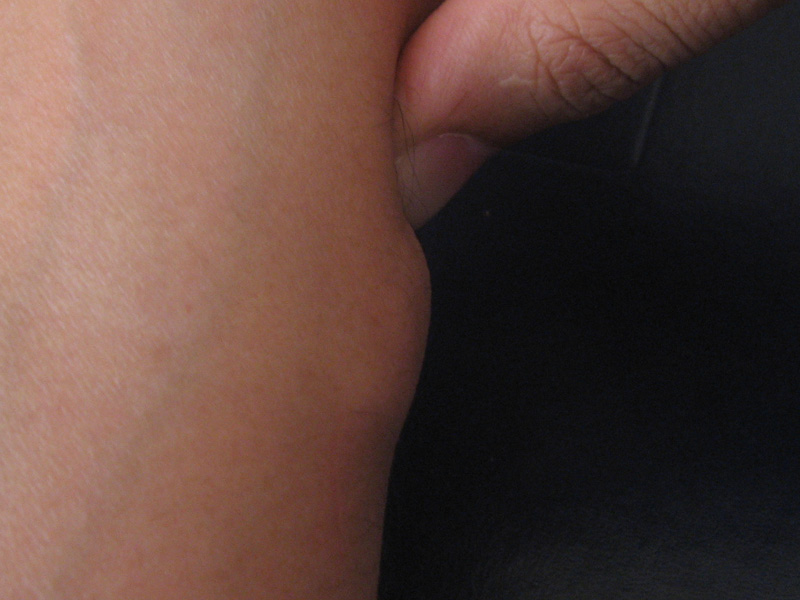Lipoma
For patient information click here
| Lipoma | |
 | |
|---|---|
| Lipoma on forearm | |
| ICD-10 | D17 (Template:ICDO) |
| ICD-9 | 214 |
| DiseasesDB | 7493 |
| MedlinePlus | 003279 |
| eMedicine | med/2720 derm/242 |
| MeSH | D008067 |
|
WikiDoc Resources for Lipoma |
|
Articles |
|---|
|
Media |
|
Evidence Based Medicine |
|
Clinical Trials |
|
Ongoing Trials on Lipoma at Clinical Trials.gov Clinical Trials on Lipoma at Google
|
|
Guidelines / Policies / Govt |
|
US National Guidelines Clearinghouse on Lipoma
|
|
Books |
|
News |
|
Commentary |
|
Definitions |
|
Patient Resources / Community |
|
Directions to Hospitals Treating Lipoma Risk calculators and risk factors for Lipoma
|
|
Healthcare Provider Resources |
|
Continuing Medical Education (CME) |
|
International |
|
|
|
Business |
|
Experimental / Informatics |
Editor-In-Chief: C. Michael Gibson, M.S., M.D. [1]
Please Take Over This Page and Apply to be Editor-In-Chief for this topic: There can be one or more than one Editor-In-Chief. You may also apply to be an Associate Editor-In-Chief of one of the subtopics below. Please mail us [2] to indicate your interest in serving either as an Editor-In-Chief of the entire topic or as an Associate Editor-In-Chief for a subtopic. Please be sure to attach your CV and or biographical sketch.
Overview
A lipoma is a common, benign tumor composed of fatty tissue. Lipomas are soft to the touch, usually moveable, and are generally painless. They grow very slowly, and in rare cases can become cancerous (Malignant liposarcoma also arises from fatty tissue.) Many lipomas are small but can enlarge to sizes greater than six centimeters. Lipoma is commonly found in adults from 40 to 60 years of age but can also be found in children. Approximately one percent of the general population has a lipoma.[1]
Types
The most common kind are known as "superficial subcutaneous lipomas"), i.e. just below the surface of the skin. Most occur on the trunk, thighs and the forearms, although they may be found anywhere in the body where fat is located.
"Lipomatosis" (ICD E88.2) is a diagnosis of multiple lipomas present on the body.
Types include:
- Superficial Subcutaneous
- Intramuscular
- Spindle cell
- Angiolipoma
- Benign lipoblastoma
- Lipoma of tendon sheath, nerves, synovium or other
Lipoma in animals
Lipoma is also found in animals. These tumors are commonly found on older dogs, but young dogs and even puppies can develop them. They appear near the surface on dogs, and can be single or multiple. They are slow growing tumors that are usually benign. Malignant forms of the tumor are very rare.
Causes
The tendency to develop a lipoma is not necessarily hereditary, although it can be in a syndrome like hereditary multiple lipomatosis where more than one lipoma develops over time. Some doctors believe that a minor injury may trigger their growth. Being overweight does not cause lipomas.[2]
Treatment
Often, treatment of a lipoma is not necessary, unless the tumor becomes painful or restricts movement. Many people have them removed for cosmetic reasons. However, if the lipoma is not completely removed during the surgery, it may grow back.
Lipomas are normally removed by simple excision. However, liposuction is another option if the lipoma is soft and has a small connective tissue component. Liposuction often results in less scarring, however it has a greater tendency to fail to remove the entire lipoma, often resulting in re-growth.
There are new methods being developed that are supposed to remove the lipomas without scarring. One of them is removal by the use of injection of various substances. Another method being developed is the use of ultrasound waves to destroy the lipoma. This can be compared with the removal of kidney stones where ultrasound is used to pulverize the stones.
References
- ↑ Lipomas at emedicine.com
- ↑ Lipoma - topic overview at webmd.com
Sources
- Lipoma Excision by Gohar A. Salam, in American Family Physician. March 1, 2002.
External links
- PSU
- Illustration
- Esophageal Lipomatosis MedPix Images
- Patient handout
- Reassuring Information
- DermNet NZ: Lipoma
- DermAtlas: Lipoma images
de:Lipom it:Lipoma he:ליפומה hu:Lipóma nl:Lipoom qu:Wira unquy sv:Fettsvulst